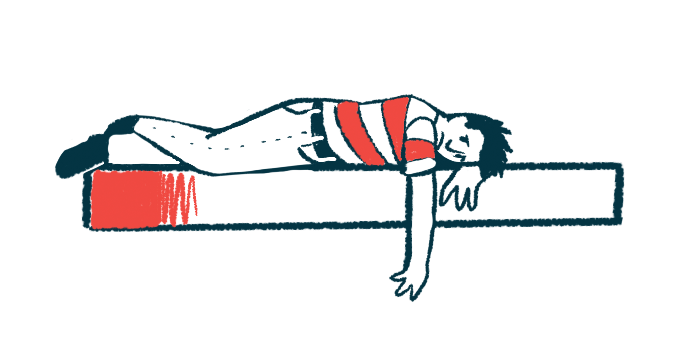Foralumab found to ease fatigue in SPMS patients in access program
Use of nasal spray reduced levels after 6 months in 7 of 10 patients in EAP
Written by |

Fully 70% of patients with nonactive secondary progressive multiple sclerosis (SPMS) who received foralumab nasal spray in an expanded access program (EAP) experienced a lessening in fatigue levels after six months of treatment.
That’s according to early findings from the EAP — a program that enables patients with serious or life-threatening conditions to have access to an experimental therapy outside of clinical trials — as reported by Tiziana Life Sciences, foralumab’s developer.
This EAP enrolled 10 nonactive SPMS patients who had previously seen their symptoms progress while on treatment with Ocrevus (ocrelizumab). Seven of them experienced reductions in fatigue after using foralumab for six months, per Tiziana.
In addition to the easing of fatigue, patients also experienced a stabilization or improvement in other clinical measures after transitioning to the multiple sclerosis (MS) therapy candidate, the data showed.
“The clinically meaningful improvement in fatigue levels seen in seven out of ten patients, as well as the stabilization or improvements in other key clinical outcome measures that were seen in all patients, underscores the potential of Tiziana’s investigational therapy to address this critical unmet need,” Gabriele Cerrone, chairman, acting CEO, and founder of Tiziana, said in a company press release.
Foralumab now being tested in new Phase 2 clinical trial for nonactive SPMS
Based on early findings from the EAP, Tiziana late last year launched a clinical trial to test the nasal spray in SPMS patients in a randomized controlled setting. The main goal is to assess changes in the activity of microglia, or brain resident immune cells known to contribute to MS progression. But researchers also will monitor changes in quality of life, and fatigue
That Phase 2 trial (NCT06292923) is already recruiting participants at Brigham and Women’s Hospital, in Boston, with additional testing sites expected to open soon, according to another press release from the company.
A total of 54 patients with nonactive SPMS will be randomly assigned to receive either a 50 or 100 microgram (mcg) dose of foralumab or the placebo for about three months.
Meanwhile, the U.S. Food and Drug Administration has allowed the company to expand its EAP from 10 participants to a total of 30 — meaning that patients who are ineligible for the trial might be able to receive the medication in this compassionate use program.
“Tiziana is glad to provide patients with [nonactive] SPMS who do not qualify to be enrolled on our Phase 2 trial … the possibility to receive open-label treatment with … foralumab. As there are no FDA approved treatments for [nonactive] SPMS, an EA program gives these patients access to this novel drug,” Cerrone said in that release.
Nonactive SPMS is a type of multiple sclerosis in which disability worsens gradually in the absence of relapses or new inflammatory lesions in the brain or spinal cord.
Fatigue is a debilitating symptom experienced by about 80% of people with MS. It refers to an overwhelming feeling of physical, mental, and emotional exhaustion, which can have a significant impact on patients’ life quality and their ability to perform daily functions.
Foralumab is an antibody-based therapy designed to reduce MS-driving inflammation by targeting the CD3 protein at the surface of immune T-cells. That’s expected to reduce the activity of inflammatory T-cells, while boosting the activation of regulatory T-cells that help to control excess inflammation.
All 10 patients in EAP stabilized or improved in key clinical measures
The ongoing EAP originally was to test the intranasal therapy in 10 individuals receiving it as part of single-patient access programs; another eight were to receive the treatment via an intermediate-sized EAP.
Participants are receiving a 50 mcg dose of foralumab, sprayed into each nostril in cycles of three weeks. In all, treatment is given three times weekly for two weeks, followed by a week of pause.
After six months of treatment, the results have shown that the therapy generally is safe, with no patients experiencing any serious side effects.
Four patients experienced so-called improvements in their disability levels — meaning they had a reduction in their Expanded Disability Status Scale (EDSS) scores, or an easing of symptoms. Another four saw actual improvements in their walking ability, as measured with the timed 25-foot walk.
The remaining patients had stable scores on these measures.
All 10 foralumab-treated patients stabilized or improved in key clinical measures, and seven showed [clinically] meaningful improvement in their fatigue at six months.
Fatigue also was measured, using the Modified Fatigue Impact Scale (MFIS). Those data showed that seven patients experienced measurable reductions in fatigue levels, with the remaining individuals maintaining stable fatigue levels.
“All 10 foralumab-treated patients stabilized or improved in key clinical measures, and seven showed [clinically] meaningful improvement in their fatigue at six months,” said Tanuja Chitnis, MD, a professor of neurology at Harvard Medical School and a neurologist at Brigham and Women’s Hospital.
Chitnis also noted that this patient population had “a disease state that typically shows a decline in function over time,” and that all “had previously clinically progressed on ocrelizumab.”
“I am pleased to see the continued clinical response to intranasal foralumab from patients enrolled in our expanded access [nonactive] SPMS program,” Chitnis added.






